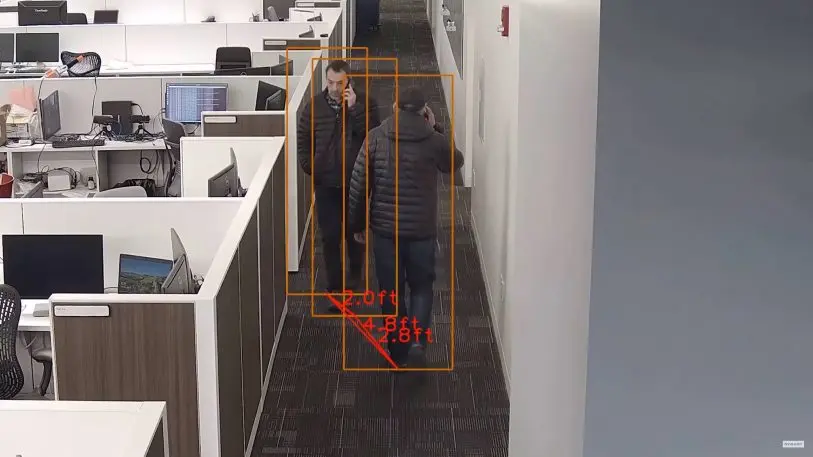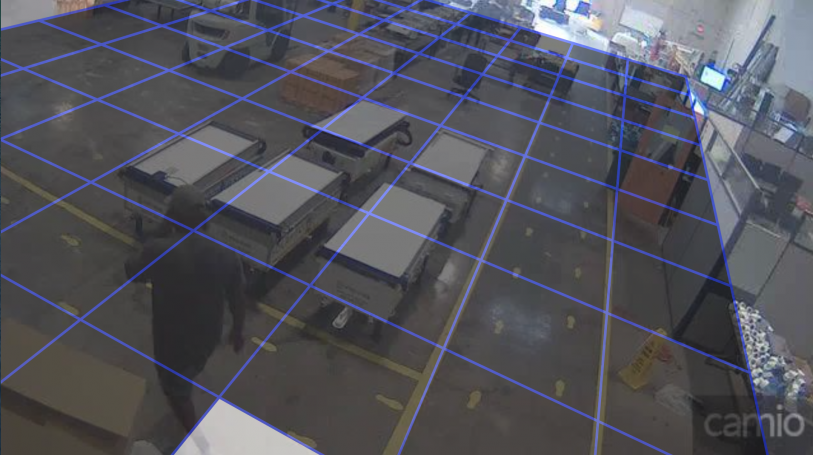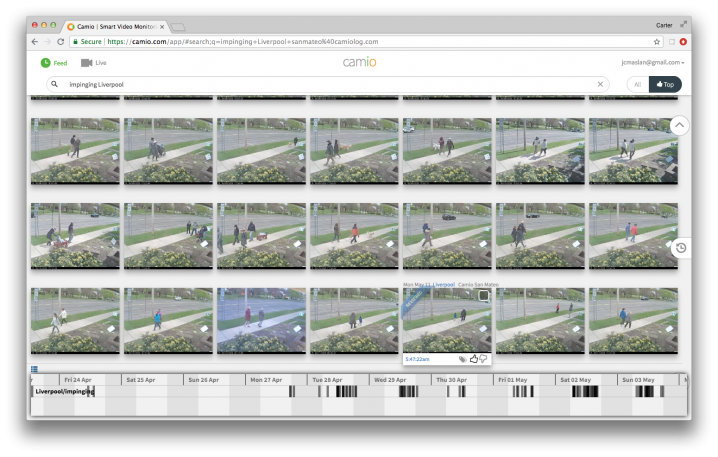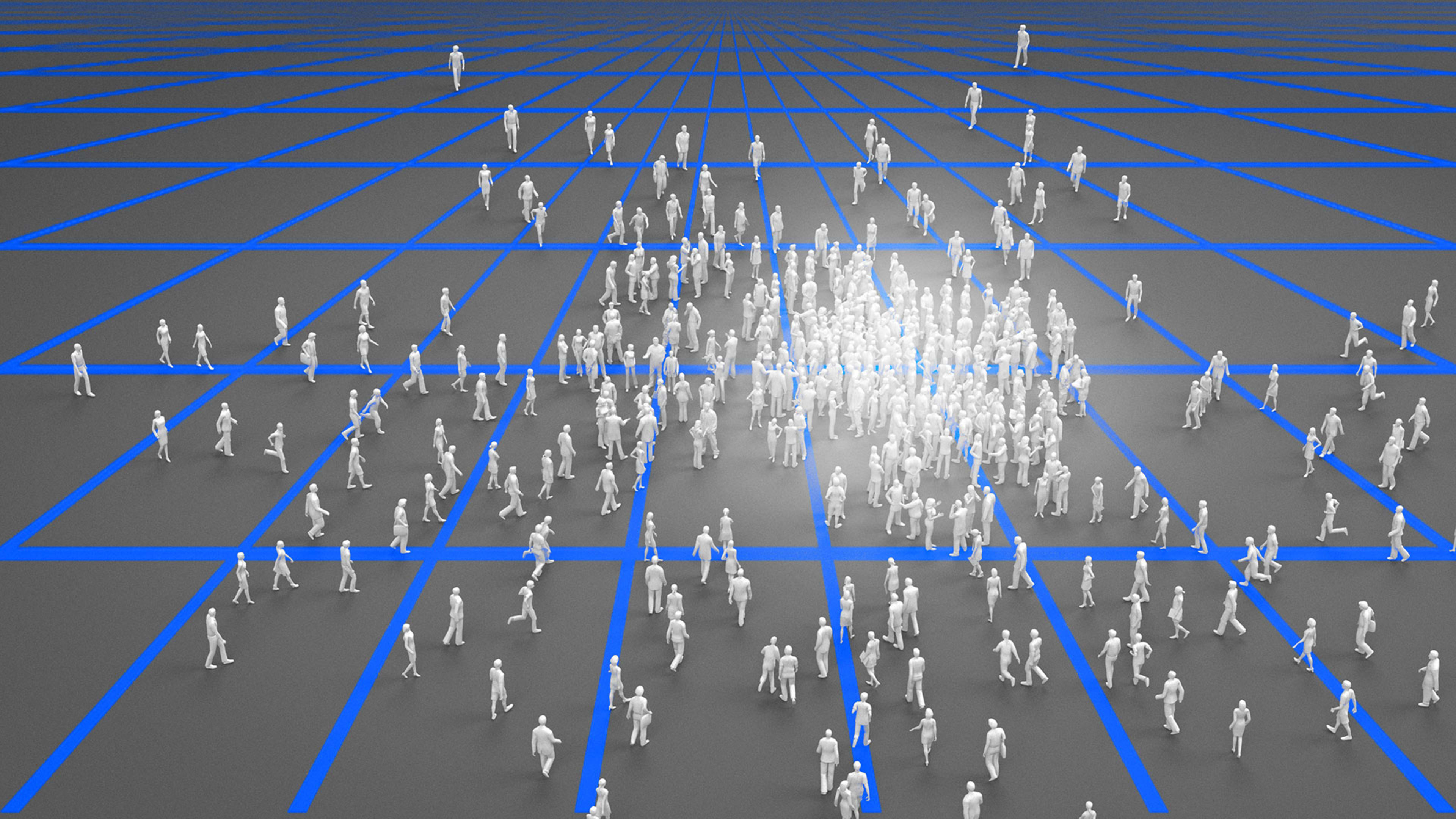Imagine pulling up to a supermarket and seeing a big red number on a digital sign outside. Instead of enticing you to come inside with sale prices or specials, this sign is estimating the amount of distance between people inside, suggesting that you stay away until the store is less crowded.
Far-fetched as it may seem, at least three companies are now racing to build surveillance systems that could make this scenario possible during the coronavirus pandemic. By combining conventional security cameras with artificial intelligence, they hope to identify where people are getting too close to one another or not wearing masks. That way, people can make smarter decisions about going out, and employers can figure out how to create safer work environments.
“You already are hearing about things like ‘Waze for occupancy and people movement,’ as opposed to vehicle movements—not just self-reporting, but automated reporting on traffic information of people in different indoor locations and public areas,” says Mahesh Saptharishi, the CTO of Motorola Solutions, which is developing a system of this kind. “I think that’s just going to be more common until people feel safe enough.”
Beyond fever detection
So far, most of the coronavirus surveillance hype has centered on thermal cameras, which use infrared sensors to pick out people who might have a fever. John Honovich, the founder of the video surveillance trade publication IPVM, says that on a scale of 1 to 10, interest in fever cameras is “like 110—it’s totally off the charts.”
Temperature-sensing cameras aren’t a panacea, though. Honovich and several other experts say the technology can be inaccurate, and IPVM has accused one vendor of faking some of its marketing. Besides, fever detection doesn’t help at all with coronavirus carriers who have no symptoms. Estimates on the rate of asymptomatic COVID-19 cases have ranged from 25% to 80% of those infected.
“Things like fever detection can be useful, but if people are not social distancing to begin with and are not wearing masks, it’s not going to be preventative,” Saptharishi says.
As more states push to reopen certain businesses and relax stay-at-home orders, companies in the surveillance business are developing technology to help enforce social distancing. Motorola’s Avigilon subsidiary, for instance, is developing software for its latest-generation security cameras that will detect when people are standing too close or not wearing masks.

Motorola hopes to start deploying this solution by the end of June, primarily for offices and factories, though supermarkets and retail stores could make use of the technology as well.
“The assumption that many facility managers have to make right now is that everybody coming into the facility is COVID-positive, so how do you minimize infection?” Saptharishi says.
The race to measure distancing
Motorola isn’t the only company that’s looking to enforce social distancing through AI surveillance. San Mateo-based Camio is also building a system to detect when people are congregating too closely or failing to wear masks. While Motorola’s system requires specific cameras and runs offline, Camio’s product works with any security camera through cloud-based software.
Carter Maslan, a former Google Maps product director who is now Camio’s CEO, says the social distancing product is a “wartime repurpose” story. Camio originally developed it to detect corporate instances of “tailgating,” in which one person swipes an entry card and several other people slip in behind. By drawing a grid in 3D space, Camio determines when people are standing too close, then presents those images in a searchable database.
[Animation: courtesy of Camio]“It’s just amazing how hard it is for people to maintain distance,” Maslan says. “It’s completely unnatural. You have to put tape on the floor to remind them, or put cones down outside the vestibule of an entrance.”

James Siojo, Sabio Solutions’s CEO, describes a “Social Distancing Factor,” which is essentially a score based on the amount of space between people—measured through Camio’s algorithms—and the percentage of people wearing masks. Each organization would be responsible for setting thresholds that it considers dangerous, and the resulting score and its associated color coding could help people decide whether to visit a store. It would take some pressure off employees to enforce social distancing themselves.
Siojo says via email that he is seeing “heavy interest” from big-box retailers in Mexico, but no agreements have been signed yet.

Meanwhile, a consortium of camera technology vendors called the NICE Alliance is building its own platform to detect social distancing, face mask use, and temperature detection, all while minimizing the amount of data sent to the cloud. NICE’s system analyzes incoming video feed locally to determine if there’s a person present and then uploads the footage for additional processing if necessary.
“When there’s nobody around, we don’t collect data, and we don’t analyze it. This not only makes things efficient, but it makes things low-cost,” says David Lee, the CEO of NICE member Scenera.
Lee hopes this solution will appeal to smaller businesses and is in talks with wireless carriers to bundle it with existing cellular-based surveillance products. He’s also pushing for adoption by elevator management firms and says a discussion is underway with the city of Tel Aviv to monitor public transportation and schools. NICE aims to launch its platform by the start of the third quarter, but it doesn’t have any agreements yet to deploy the technology.
Light-touch enforcement
John Honovich, the IPVM founder, says there is a risk of this technology being oversold.
While face masks are fairly easy for any AI camera system to detect, some cameras may not be set up at the appropriate angles to determine the distance between people. They could also be thrown off by groups of people who don’t need to separate themselves, such as families walking together. It’s also worth noting that distance itself can be an imperfect proxy for safety. Virus particles can travel farther than six feet, and the duration of contact is something these systems will have to consider as well.
“The analytics are hard to do correctly, and the logistics of managing it are very challenging to properly implement,” Honovich says.
John HonovichThe analytics are hard to do correctly, and the logistics of managing it are very challenging to properly implement.”
Facilities that monitor crowd density also risk running into a backlash, especially in the United States, where tensions over social distancing enforcement have started boiling over. Last week, in Flint, Michigan, two men were charged with murdering a security guard at a Family Dollar store after an altercation over mask use. In New York City, police have been accused of disproportionately targeting black and Latino residents for violating the city’s guidelines. Meanwhile, lockdown protesters have deliberately avoided social distancing at rallies where they claim their freedoms have been infringed upon.
Still, surveys show that the vast majority of Americans—73%, according to a Politico/Morning Consult poll—continue to support social distancing even at the expense of the economy. If stores want to convince customers to come inside, they may have to be realistic about the risks.
“This is something that gives [customers] advanced notice, or some amount of advanced information, so that they can make more considered decisions as they go about their lives,” Motorola’s Mahesh Saptharishi says.
Allaying people’s privacy concerns might be harder, but Saptharishi notes that AI surveillance can on some level protect privacy. In offices, managers wouldn’t have to scrutinize large amounts of camera footage themselves, and smarter proactive measures could help reduce direct confrontations over social distancing between workers.
“Ideally, we don’t want that much information being regularly looked at, because then employees and customers feel uncomfortable that they’re being watched on a regular basis,” Saptharishi says.
In any case, the companies building these solutions don’t think we’ll see anything along the lines of government-mandated surveillance for companies. As Camio’s Carter Maslan argues, businesses that can document their social distancing tactics might be better protected against liability claims, and stores could have a better chance of drawing people back in.
In other words, there’s plenty of incentive for social distancing surveillance already. Maslan says he’s had to hire extra people to keep up with inquiries.
“If you want your employees to be safe, and you want consumers to be confident, you as a manager want to know if you have a problem,” he says.
Recognize your brand’s excellence by applying to this year’s Brands That Matter Awards before the early-rate deadline, May 3.
